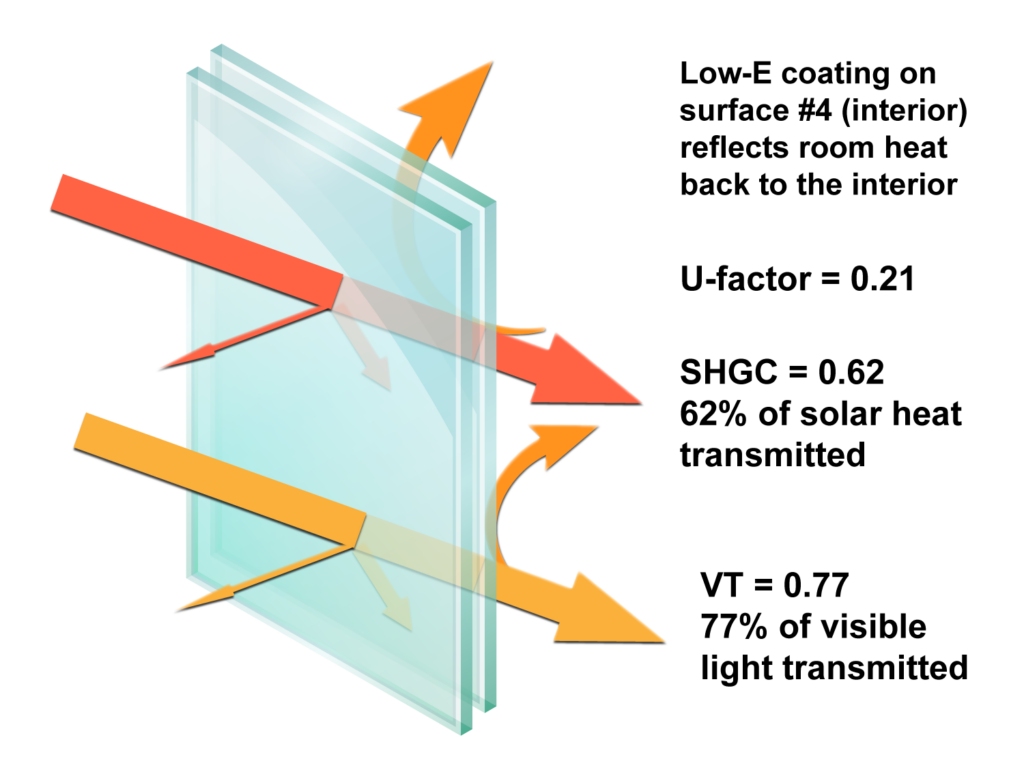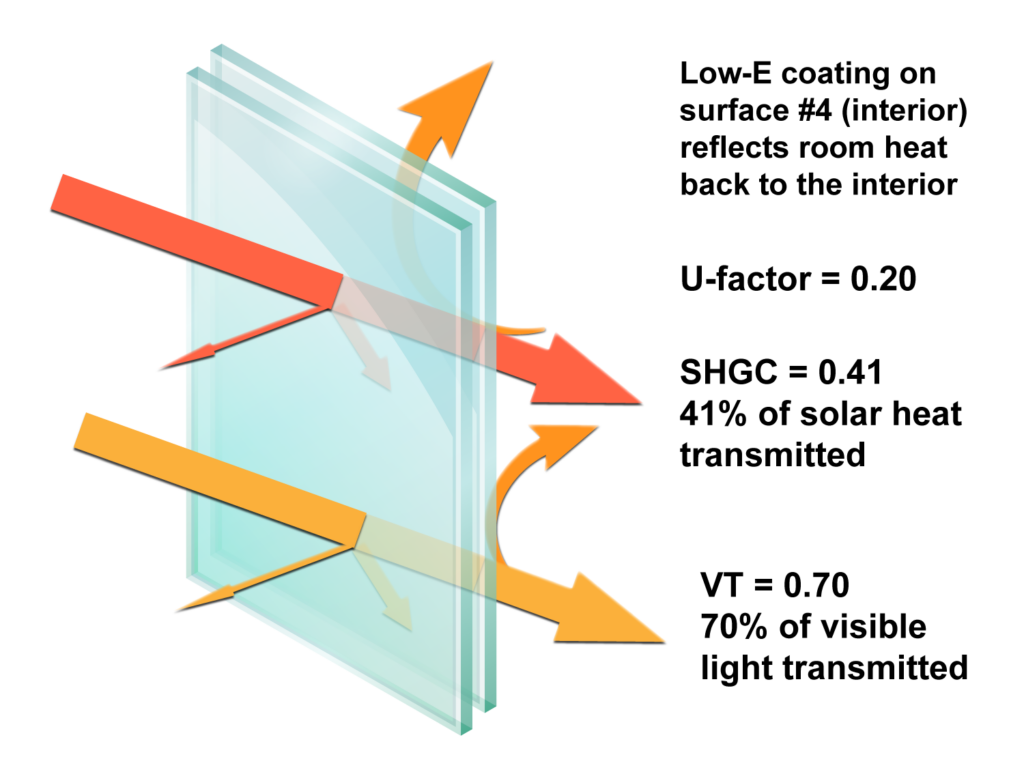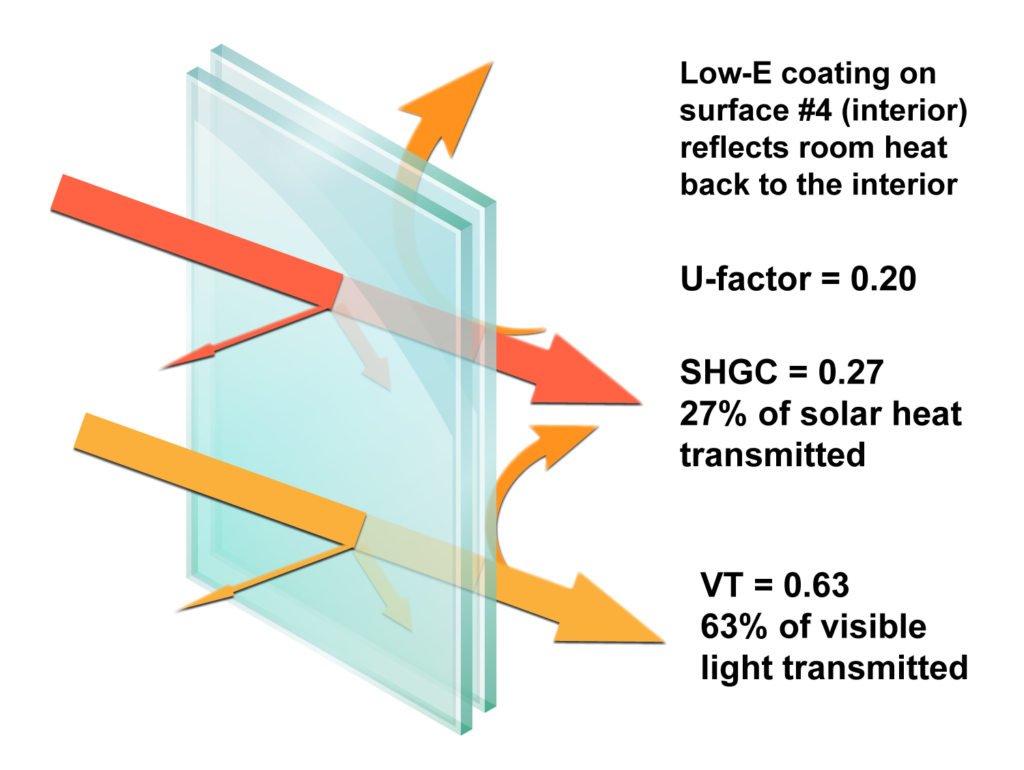
Glazing Types - Double Low-E Glazing with Roomside (4th surface) Low-E
Adding an addition roomside (also known as the 4th surface) low-E coating to the low-E coating in an insulating glazing unit allows for increased thermal performance without having to add another layer of glass. Infrared heat is generated inside a room. Adding this roomside low-E coating reflects the heat back into the space which reduces the amount of radiant heat loss through the glass.
 Double-Glazed, High-solar-gain Low-E with Roomside (4th surface) Low-E Glass
Double-Glazed, High-solar-gain Low-E with Roomside (4th surface) Low-E Glass
This figure illustrates the characteristics of a typical double-glazed window with a high-solar gain low-E glass with argon gas fill and a roomside low-E coating. These windows are designed to reduce heat loss but admit solar gain. High-solar-gain low-E glass products are best suited for buildings located in heating-dominated climates and are the product of choice for passive solar design projects.
High-solar-gain low-E glass is often made with pyrolytic low-E coatings, although sputtered high-solar-gain low-E is also available.
Center of Glass Properties
Note: These values are for the center of glass only. They should only be used to compare the effect of different glazing types, not to compare total window products. Frame choice can drastically affect performance. These values represent double glazing with a 1/2″ air gap.
Whole Window Properties – Double-Glazed, High-solar-gain Low-E with Roomside (4th surface) Low-E Glass


Double-Glazed, Medium-solar-gain Low-E with Roomside (4th surface) Low-E Glass
This figure illustrates the characteristics of a typical double-glazed window with a moderate-solar-gain low-E glass with argon gas fill and a roomside low-E coating. These windows are often referred to as spectrally selective low-E glass due to their ability to reduce solar heat gain while retaining high visible transmittance. Such coatings reduce heat loss and let in a reduced amount of solar gain making them suitable for climates with both heating and cooling
Medium-solar-gain low-E glass is often made with sputtered low-E coatings, although pyrolytic moderate-solar-gain low-E is also available.
Center of Glass Properties
Note: These values are for the center of glass only. They should only be used to compare the effect of different glazing types, not to compare total window products. Frame choice can drastically affect performance. These values represent double glazing with a 1/2″ air gap.
Whole Window Properties – Double-Glazed, Medium-solar-gain Low-E with Roomside (4th surface) Low-E Glass


Double-Glazed, Low-solar-gain Low-E with Roomside (4th surface) Low-E Glass
This figure illustrates the characteristics of a typical double-glazed window with a low-solar-gain low-E glass with argon gas fill and a roomside low-E coating. As with moderate-solar-gain low-E glass, these windows are often referred to as spectrally selective low-E glass due to their ability to reduce solar heat gain while retaining high visible transmittance. Compared to most tinted and reflective glazings, this low-E glass provides a higher level of visible light transmission for a given amount of solar heat reduction. Variants on low-solar-gain low-E coatings have also been developed which may appear slightly tinted. This type of low-E product reduces heat loss in winter and substantially reduces solar heat gain both in winter and in summer. Thus, low-solar-gain low-E glazings are ideal for buildings located in cooling-dominated climates.
Low-solar-gain low-E glass is typically made with sputtered low-E coatings consisting of either two or three layers of silver (also called double-silver or triple-silver low-E).
Center of Glass Properties
Note: These values are for the center of glass only. They should only be used to compare the effect of different glazing types, not to compare total window products. Frame choice can drastically affect performance. These values represent double glazing with a 1/2″ air gap.
Whole Window Properties – Double-Glazed, Low-solar-gain Low-E with Roomside (4th surface) Low-E Glass
